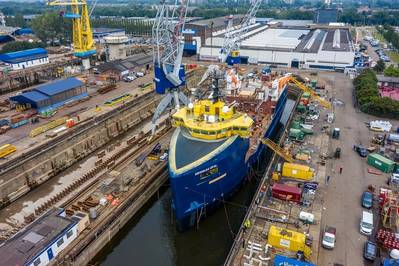Damen Converts PSV into Fish Feed Carrier for Eidsvaag
Damen Shiprepair Amsterdam (DSAm) completed a conversion project for Norwegian company Eidsvaag which saw a platform supply vessel (PSV) transformed into a fish feed carrier dubbed Eidsvaag Opal.
Among other things, Damen was required to extend the vessel by 5 meters, which involved the yard cutting the hull in two and inserting in new steel sections. Damen was also required to widen the beam of the vessel – using a series of side boxes – to give additional stability and cargo capacity. In total, the project required 875 tons of steel work.
The yard also integrated 35 new silos and a big bag hold, enabling Eidsvaag Opal to transport up to 2,800 tonnes of fish feed. Damen also outfitted the vessel with five new cranes and a discharge system of conveyors, buckets, elevators and a discharge arm.
The project also required considerable electrical work, carried out by FMJ Marine Automation. The supplier removed approximately 480 cables – approximately 15 km – from the old cargo systems alone. In total, the company pulled 51 km of cable and connected 1,237 cables on the project.
The vessel will operate in the Fjordfrende collaboration. This collaboration will be operated by Eidsvaag for Skretting and Cargill. Ordinarily, Skretting and Cargill are competitors in the fish feed market, but are collaborating in outbound logistics. The partnership is based on a number of horizontal logistics projects receiving funding from the EU Commission, aiming at increasing sustainability and efficiency in the aquaculture industry. As a result of Fjordfrende, the CO2 emissions of both companies will be reduced by one fifth, some 10-20 million kg CO2 per year.


















